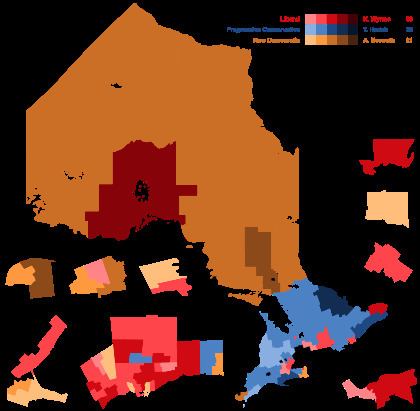June 12, 2014 (2014-06-12) 42nd → 53 seats, 37.65% 37 seats, 35.45% 48 37 Date 12 June 2014 | Turnout 52.1% 37 seats, 35.45% 17 seats, 22.74% 37 21 | |
 | ||
Winner Kathleen Wynne | ||
Ontario general election 2014
The 41st Ontario general election was held on June 12, 2014 to elect the members of the 41st Parliament of Ontario. The Liberal Party won a majority of seats in the legislature, allowing its leader, Kathleen Wynne, to continue as premier, moving from a minority to majority government. This was the Liberals' fourth consecutive win since 2003 and an improvement from their performance in the 2011 election. The Progressive Conservatives under Tim Hudak were returned to the official opposition; following the election loss, Hudak announced his resignation as Progressive Conservative leader. The New Democratic Party under Andrea Horwath remained in third place, albeit with an improved share of the popular vote.
Contents
- Ontario general election 2014
- Timeline
- Opinion polls
- General opinion polls
- Incumbent MPPs not running for re election
- Northern Ontario
- Economy
- Transit
- Media endorsements
- Public figure endorsements
- References
The election was called on May 2, 2014, by Lieutenant Governor David Onley, upon the recommendation of Wynne following the announcement that the NDP, whose support was critical to the survival of the Liberal's minority government in the Legislative Assembly, would vote against the Liberals' proposed budget.
With the election, Wynne became the first woman and first rookie leader to lead her party to a majority victory in an Ontario general election.
Pairing off the top three parties, swings were calculated to be:
Timeline
Opinion polls
Voting intention polls released throughout the election campaign were distinctly inconsistent and contradictory, as shown in the graph and table below. During much of the campaign, different pollsters persistently disagreed, frequently by important margins, on whether the Liberals or Progressive Conservatives held the lead, though by the final days most polls showed the Liberals marginally to comfortably ahead. Still, polls completed on the last day of the campaign by Ipsos Reid and EKOS showed vastly divergent support for the NDP, at 30% and 19%, respectively. Also of note, although four different pollsters released results among "likely voters" alongside their results among all eligible voters in an effort to better predict the outcome of the election based on expected voter turnout, in all cases the former proved to be overall poorer predictors than the latter.
General opinion polls
1 Innovative Research states, for Province Wide Online Survey, "Margin of error not applicable, online samples not random."
2 Data shown above for campaign-period polls are top-line results, typically among all eligible voters. However, certain pollsters additionally report results among "likely voters" in an effort to better predict the actual outcome of the election. When available, these alternative results are shown in the following table:
Incumbent MPPs not running for re-election
Liberals
Progressive Conservative
Northern Ontario
Economy
Unemployment in Ontario was a major political issue. In particular, the manufacturing sector had shrunk by about 30% or more than 300,000 jobs since 2002.
The Progressive Conservative Party of Ontario proposed a plan called "Million Jobs Plan", outlining their strategy for job creation and economic growth. By reducing tax, government services, energy costs and regulations the PCs projected to create a cumulative 507,488 jobs over eight years. The plan also called for the reduction of 100,000 civil service jobs. Economists and critics noted fundamental mathematical errors with the PCs' projections. They held, even if the PCs' own data were correctly tabulated, only 50,000 extra jobs would be created (in addition to the 500,000 that would be created anyway without any policy change).
The Ontario Liberal Party proposed the 10 year "Jobs and Investment Plan", which proposed infrastructure investments as their main strategy to create jobs.
The Ontario New Democratic Party platform called for targeted tax credits and incentives to encourage job creation.
The Green Party of Ontario policy proposal stated that it would "focus on your job by lowering payroll taxes for small businesses" as well as investing in transit infrastructure and subsidising energy-saving home improvements.
The Ontario Libertarian Party called for mass privatization, lower taxes and general deregulation, eliminating many business requirements such as permitting, insurance and certification that they considered to be interfering with job creation. Their platform called for government spending to be limited to "only core functions of government; defending life, liberty, and property" and as such would have eliminated industry subsidies or incentives of any kind, particularly in the energy sector.
The Communist Party of Ontario called for raising the minimum wage to $19/hr as well as introducing a guaranteed annual income, nationalization of the domestic steel industry, and investments in public housing, infrastructure and social programs, while shifting taxes from lower to higher income-earners and businesses.
Transit
Due to rapid urban and suburban expansion in southern Ontario, traffic congestion had been increasing greatly. A 2013 study by the CD Howe Institute determined that it was costing $7.5-11 billion annually for the economy of Toronto alone.
The Liberals promised $29 billion in infrastructure spending, $15 billion of which would go towards building new transit (mostly LRT) lines in the GTHA, based on the outline of Metrolinx's The Big Move plan, as well as an LRT in Ottawa. A high-speed rail line crossing the province from the southeast into Quebec was also planned. The PCs promised to finish building the Eglinton Crosstown, but cancel all the other planned lines, and instead focus on quickly expanding GO service. The NDP plan was similar to the Liberal plan, but included an extra $1 billion to get certain projects built faster.
Media endorsements
The following media outlets made endorsements during the campaign:
Liberal
Progressive Conservative
New Democratic Party
Explicitly not endorsing any party
Public figure endorsements
The media has reported the following endorsements by public figures during the campaign:
